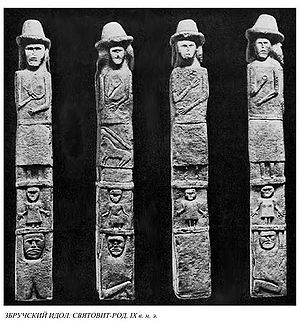- Baptism of Poland
-
The Baptism of Poland (Polish: Chrzest Polski) was the event in 966 that signified the beginning of the Christianization of Poland, commencing with the baptism of Mieszko I, who was the first ruler of the Polish state. The next significant step in Poland's adoption of Christianity was the establishment of various ecclesiastical organs in the country during the 10th and 11th centuries. This included the building of cathedrals and the appointment of clergy. This date should not be confused as the independence day of Poland.
In adopting Christianity as the state religion, Mieszko sought to achieve several personal goals. He saw Poland's baptism as a way of strengthening his hold on power, as well as using it as a unifying force for the Polish people. The exact place of Mieszko's baptism is disputed, historians having alternately argued that Gniezno, Poznań, Cologne or even Rome was the site of the event. Mieszko's action proved highly influential; by the 13th century, Roman Catholicism had become the dominant religion in Poland, although pagan resistance denoted with the historic term 'Pagan reaction' remained until the 1040's.
Contents
Svetovid
 The Zbruch idol, on display in the National Museum in Kraków, Poland God of war, fertility and abundance
The Zbruch idol, on display in the National Museum in Kraków, Poland God of war, fertility and abundance
Svetovid was the god which the people of Poland believed in before adopting to Christianity in 960 A.D. Svetovid is the Slavic God of war, fertility and abundance.
People's Republic of Poland
In 1966, the People's Republic of Poland witnessed large festivities on the 1000-year anniversary of those events,with the Church celebrating the 1000 years of Christianity in Poland, while the communist government celebrated the secular 1000 years of Polish State.[1]
See also
- Adalbert of Prague
- Dagome Iudex
- Pagan reaction in Poland
- History of Poland (966-1385)
- Christianization of Kievan Rus'
Notes
- ^ Norman Davies, God's Playground, Google Print, p.17
Categories:- 966
- 10th century in Poland
- History of Poland (966–1385)
- History of Catholicism in Poland
- Baptism
- History of Christianity by geography or ethnicity
- 10th-century Christianity
- Polish history stubs
- Roman Catholic Church stubs
Wikimedia Foundation. 2010.

